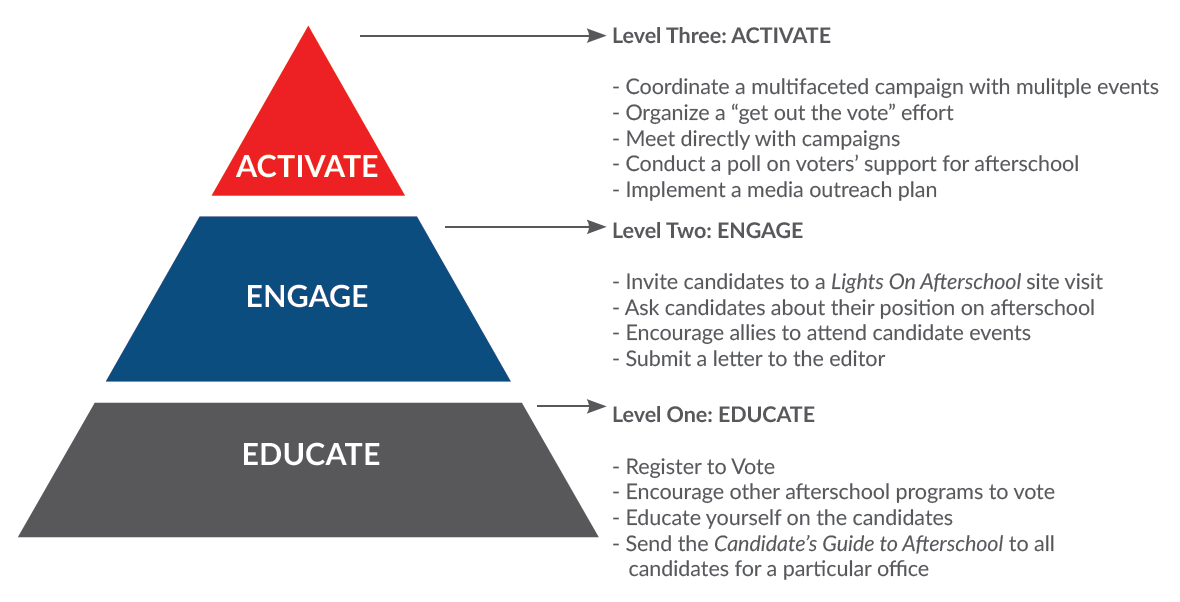Whether you have the time and resources to run a coordinated, multi-pronged afterschool issue campaign, or you are just looking for some ideas on how to raise the profile of afterschool during election season, this kit can inform your planning, help you assess what you can undertake and hopefully make your job easier.
To execute a campaign to make afterschool an election issue, it is important to understand your community and the election that you are targeting.
Two basic communication tools are contact lists and a website. Your contact list will allow you to call or send out blast emails to your supporters and encourage them to take action.At the outset, you and your partners may want to pool your lists to create a master database. You should continue to build this list throughout the campaign by hosting voter registration, public education, and other “list building” events.
A campaign website will allow you to post event and campaign information, conduct polls and allow the general public to find out more about your issue.
Remember to approach them early — offering your assistance can help ensure afterschool has a place in the event.
Identify community trusts, local foundations and other groups that may want to fund an initiative like this. Remember, you are more likely to find funders when you undertake a campaign like this with partners.
The Election Toolkit is filled with information on campaigning; however, you should not feel like you have to complete every step and participate in every recommended activity in order for your efforts to be successful. Pick and choose your strategies based on the time you are able to spend and the resources available—the strategies most effective to help you reach your campaign goals.
The diagram below offers suggestions for how you should focus your efforts depending upon the level of involvement you choose. Participation at any of these levels is a meaningful accomplishment that will help to advance the goal of afterschool for all.

Immediately following the election, organize meetings with your partners and afterschool campaign leaders to discuss what worked and what did not. Document and compile this analysis into a document for use by other advocates around the country. The goal is to make afterschool an issue, not just in your neighborhood, but in communities around the country. By learning from each other, every subsequent campaign may be able to build on the successes while avoiding the mistakes of prior campaigns. Continue to communicate with the new office holder, and become a resource for their transition teams.
It can be confusing to know how you can involve yourself in an election if you work for a nonprofit organization. There are a couple of simple ground rules that you need to follow:
Candidate: any individual who offers himself or herself, or is proposed by others, as a contestant for an elective public office.
Public office: any position filled by a vote of the people at the federal, state or local level—ranging from the president of the United States to the local school board—and elective party offices, such as local area committee persons and party nominations.
An organization may take positions on public policy issues, including issues that divide candidates in an election for public office, as long as the message does not in any way favor or oppose a candidate. Be aware that the message does not need to identify the candidate by name to be prohibited political activity. A message that shows a picture of a candidate, refers to a candidate’s political party affiliations, refers to an election, or includes other distinctive features of a candidate’s platform or biography may be prohibited political activity.
A website is a form of communication. If an organization posts something on its website that favors or opposes a candidate for public office, it is prohibited political activity. It is the same as if the organization distributed printed material, or made oral statements or broadcasts that favored or opposed a candidate.
If an organization establishes a link to another website, it is responsible for the consequences of establishing and maintaining that link even if the organization does not have control over the content on the linked site. Because the linked content may change, the organization should monitor the linked content and adjust or remove any links that could result in prohibited political activity.